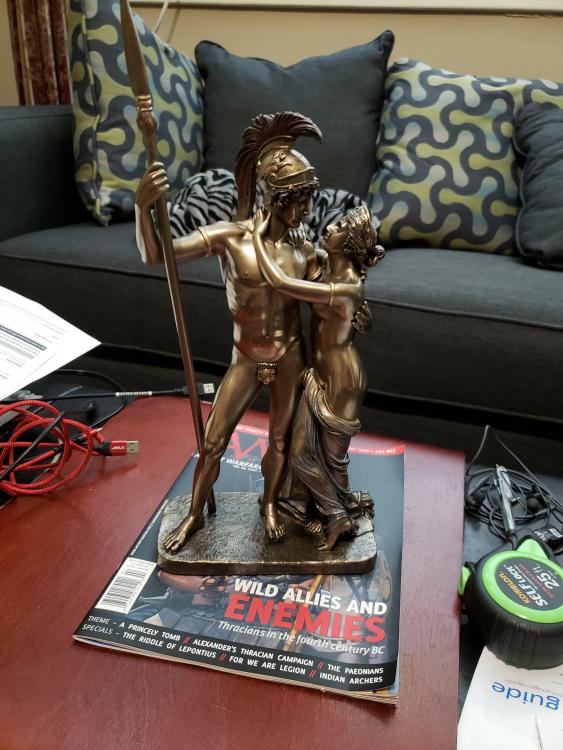Leaderboard
Popular Content
Showing content with the highest reputation on 2018-09-30 in Posts
-
Gaia animals AI improvement currently when a unit attack to a Gaia wild animal, Elephant for example then Elephant start to follow all over the map till one of them die (they have very good GPS and tracking system ) ... and they skip any other unit who attack them/under way after first attack ... Suggestion: 1- Wild animals not following all over the map , and they follow attacker only for a range , their territory 2- They attack to nearest unit (any unit from any civ) not only the one who attack them (Basically any unit near to them )\ 3- Wild animal speed increase when they rage and start to attack , when a lions/elephants etc get angry and start to attack they dont walk with coquetry 4- if possible , when there is a group (herd/flock) of lions or Elephant and when a player attack them then all of them got rage and start to attack and not only one of them3 points
-
2 points
-
Well the next cinematic is almost done, should be up within the next week. I figure people here are more interested in gameplay though, so here's a sneak peek at the next Civ that's being added into Hyrule Conquest:2 points
-
In 1v1 the Briton civilization has: - one huge advantage = you can get to max pop (build your full army) sooner than any other civ - one huge disadvantage = poorer units, if you build your army and do not immediately attack, your opponent will be able to build his own full army and will defeat you as he has better units Because of this, Britons are very much like zerg in startcraft. So this is the strategy when playing Britons: build a lot more units a lot faster than your enemy, and when reaching 150 population urgently attack. If you fail that attack you lose, if you delay that attack you lose, if you are not the first to reach max pop you lose, if you do not know how to use many but weak units in combat you lose, and so on. Note: if you are a beginner today, follow this guide and you will reach a high score simple because there are also a lot of beginners that make huge mistakes. You need to memorize this build order, and always play it on normal Mainland map and configure your building batch size to 2: 1 - with your initial 4 women build granary near berries 1 - with your initial 4 soldiers build warehouse near wood 1 - put your horseman to collect food from chickens/sheeps near cc 1 - put your cc to train 6 women and set rally point to berries 2 - send your dog to go near the enemy base 3 - make the 100 wood upgrade from granary, that upgrades the berry gathering rate 4 - keep building women and send them to gather wood, your cc should be constantly training 5 - when your pop is 21 build a house 5 - use your dog to find an enemy woman ans harras him. Try to kill one woman, sacrifice your dog without regrets 6 - when you reach 24 pop now build slingers instead of women, pay attention to build a house whenever you are getting close to your pop limit 6 - build a tower near your berries, you need to defend against enemy harrass 7 - when your horseman has finished collecting all chickens send him to scout (see opponent building location) and then harass opponent (killed a villager) 7 - when your stone is depleted, train again women instead of slingers Since a 1v1 game should take somewhere between 20 and 25 minutes, the steps above are roughly your first 7-8 minutes, that makes it about a 3rd of the game. It should be memorized. Now comes the second third of the game: In these 7 minutes you need to achieve these goals: - have 9 full farms, meaning 45 women - advance age (500 food and 500 wood) - reach 150 population, out of which 45 are women and 105 soldier - have at least 3 barracks The third and last part of the game is your attack: you leave 10 soldiers to collect wood, and your 45 women to collect food. Thus you have 95 soldiers with which to attack. 1 - your goal is to ruin his economy = capture houses, kill women, capture unguarded barracks. What does it mean: 1.a - avoid towers of fortress (he will not have one at this moment if you played correctly) 1.b - it is very useful to know where his buildings are, thus you can attack form behind, where ha has houses or farms or barracks/blacksmith/marketplace without towers nearby, you gain this info in stage one, with your horse 1.c - he will pull his soldiers form collecting resources and use them to defend. Thus he has no more economy this is why this attack is so powerful 1.d - you have 150 units, out of which you attack with 95 soldiers. If you play it correctly, since any other civ does not get bonus population from his warehouses/etc, he will only have 110 population, out of which half are women, effectively you outnumber his soldiers 2 to 1 (or maybe just 3 to 2) 1.e - you keep your army together, while he has to pull his soldiers from different spread out places. If only a part of his army attacks you at one point, you have effectively a 5 to 1 superiority 1.f - your army composition is 3 ranged units (slingers or skirmishers) for each spearman 2 - your barracks and cc must keep training soldiers, so that you get reinforcements in combat 3 - proud opponents cannot believe they have lost so they will try some weak attack on your base with a few troops. Use those 10 soldiers gathering wood to defend 4 - if game drags on, advance last age and build yourself a fortress - if it gets into an attrition war, you have lost Most important notes on combat (this is what happens in the third part of your game): - your army should be 1 spear for every 3 ranged, so a 75% ranged units ratio - range units battles end up very quickly and you should devote your entire attention to them - the moment you need to pay most attention to is this combat moment, when your army engages his - the one who has his ranged units close together wins against the one with dispersed units, worse even, the one whose units move in a line and attack one by one - do not let your units run towards your enemy, as his ranged soldiers will kill your units one by one - put spearman in front of slinger, as spearman move slower they will spend most of the battle moving instead of doing damage - slingers do the most damage per second - in the heat of combat, moving instead of doing damage is wasteful - attacker will lose if he sends his army to an equally large army that is standing together still - put your units to most aggressive stance (they will engage any enemy), just to avoid useless movement during combat - never fight combats where your opponent has the same amount of army as you. Always attack only when you outnumber him. Retreat when he has the same or more. - the ideal situation when your army stands still grouped together, on aggressive stance, and he attacks you with his smaller army. Many people will attack you with roughly equal (slightly smaller) armies composed of better units. This is a psychological defect of the human brain that is very hard to resist. Easy win as moving close to you will kill 15% of his army before doing any damage. - never fight in range of towers or fortress If you follow this build order (I will update with timers and exact builds, maybe make a 1v1 commented match to explain) there is nothing he can do to mediate your advantage, thus you will only lose if you make some combat/late game/get greedy mistakes. Stay tuned for more, I will be adding and editing this post.1 point
-
Nobody watches replay cuz there is no scroll back of forward. Now I axe you to implement this fast1 point
-
1 point
-
I totally agree, shame I can think of the countless villagers that will get mauled to death because of a charging wild animal, like aoe2.1 point
-
Dear @amadeus , yes its true and not only the replay feature... there are other parts also needs to be added or to improve thats why this game is still in Alpha (not even Beta) phase and there is huge difference between this game and other commercial games you see in the market .... its free open source and handle by community , they are not hired to provide this game , they are students/ freelnacers / working for different companies / maybe totally different jobs... they have families , personal stuff... and they are contribute to this game as much as they can from their free time, The point that i really like about this project is: everyone welcome here to help and contribute (guys correct me if im wrong here) you also if you think there is part that you can help that would be great .. and sure every one thank u1 point
-
Indeed. There are enough similarities between the myths of Deucalion, Noah, Utnapishtim, Atrahasis, and Ziusudra that there is a consensus all these have a common, Mesopotamian, origin. It has even been suggested the "deluge" of the story was a severe flooding of the Euphrates in c. 2900 BC. It is not unusual that myths are borrowed and retold elsewhere; many (possibly most) Greek myths came from the Near East; e.g Adonis is Tammuz/Dumuzid. As for the Bible and Torah, Genesis was probably codified shortly after Cyrus allowed the Jews to return from Babylon to Jerusalem, maybe as a consequence of the construction of the Second Temple, subsidized by Darius, i.e. somewhere around 500 BC. The Mesopotamian versions of the flood myth were written down more than a thousand years earlier and it is highly unlikely the Jews living in Babylon for decades never heard or read the Babylonian version. Anyway, Genesis consists of two different parts, the primeval (Genesis 1-11: creation of the world; Adam and Eve; their descendants; Noah; his descendants, Tower of Babel, etc.) and the ancestral (Genesis 12-50: Abraham, Isaac, Jacob; Joseph and his brothers, the migration into Egypt) history. The latter serves as an introduction to the stories of Moses (Exodus, Leviticus, Numbers, Deutoronomy). Many scholars believe the primeval part of Genesis (1-11) is a later addition to serve as an introduction to the ancestral part of Genesis (12-50). Also, Genesis 1-11 is the result of merging at least two different versions, which explains why this part frequently contradicts itself, e.g.: the first woman is created twice, first simultaneously with the first man (Gen 1:27), later afterwards out of a rib of him when he was sleeping (Gen 2:21-24). (In Medieval times the explanation was that they were two different women, the former, Lilith, considered herself an equal of the man, and was not willing to obey him, therefore God created the latter, Eve, out of Adam, to serve him as an obidient wife.) Noah collects one pair of each animal (Gen 6:19) or seven pairs of all clean animals (Gen 7:2) the deluge lasts 40 days (Gen 7:17) or 150 days (Gen 7:24) Noah releases a raven once (Gen 8:6-7) and (?) a dove thrice (Gen 8:8-13) Anyway, the story of Noah in the Bible actually confirms a Mesopotamian origin of the myth, not vice versa.1 point
-
Hey, If you want this fast you'll have to code it yourself. We are all doing this on our free time and unfortunately for you this is not a top priority for us. Next time though, you might want to ask more nicely.1 point
-
1 point
-
1 point
-
Thanks SirPope for spotting and making those fixes. I have added these 2 files to my own development version and will sent them over during the merge for the next release/patch.1 point
-
Hence the multiple meanings of "myth." That explanation does have a good scientific framework. What makes the subject interesting to me personally is the comparative mythological aspects of the story/stories, and how despite the linguistic, cultural, and geographical differences, there are so many parallels worldwide. If this topic was more popular, I'd definitely have a prediction for the next Watch.Mojo top ten video.1 point
-
1 point
-
1 point
-
This should let you play as 0 AD civ, the AI on the other hand requires some tinkering. I removed BasicSoldier from the class list of template_unit_infantry. The AI will not use the barracks anyways without editing config.js. It won't use it properly without a bit more edits in the other AI files. template_unit_support_female_citizen.xml template_unit_infantry.xml -- Let me know if it works now :)1 point
-
1 point
-
Delenda Est will add approximately 60 civilizations (lol) to the game 0 A.D. all based on 14 culture group in the Eastern Hemisphere between 500 BC and AD 500. It's my hope that the cultures UI mod can get working again to help make the culture groupings a real. Each civ will have its bonus and penalty as well as each culture will have its bonus and penalty. A civ can be in more than 1 culture group, giving the attributes, bonuses and weaknesses of each culture group it is in. GUI Something like this, but with drop-down list for cultures. Final civilization list with all modded civs, original civs, and the Han from Rise of the East: Africans Common Attributes: African war elephants, strong land trading Balkans Common Attributes: Skirmishing bonuses, good sword infantry, high attack, low armor Celts Common Attributes: Weak buildings, fast construction, fast-moving units, Rotary Mill Chinese Common Attributes: Massed infantry, population bonus, use of fire, crossbows Egyptians Common Attributes: Temple and healer bonuses, strong expensive tier 2+ buildings, free tier 1 buildings, mercenaries train instantly Germans Common Attributes: Capturing bonuses, "Ambush" attack bonus within forests, shield wall, high attack, low armor, ox cart dropsite, weak wooden buildings Hellenes Common Attributes: Theater (Hellenization bonus), technology cost bonus, strong sea trade, strong spearmen Iberians Common Attributes: Free circuit of walls at start, "Ambush" attack bonus within forests, monument, flaming pitch, strong fortress Indians Common Attributes: Armored war elephants, population bonus, good archery Iranians Common Attributes: Infantry train very fast but weak, good cavalry, strong land trading, Palace Italians Common Attributes: Good melee infantry, good siege equipment Nomads Common Attributes: Movable buildings, less restrictive territory concept, good cavalry, raiding and looting bonuses, no stone walls (except for Parthians) Punics Common Attributes: Champions trained at temple, mercenary concept is flipped, strong sea trade and navy Successors Common Attributes: Pike infantry, Library, siege tower1 point
-
1 point








.thumb.png.0d87fc71cb8a644c5d862ceabac1e0d5.png)
